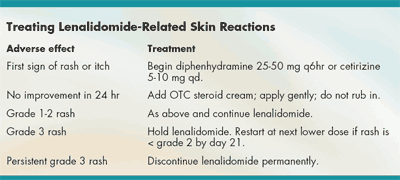Nurses Manage Lenalidomide Skin Reactions
The thalidomide analogue lenalidomide (Revlimid), which isapproved for use in multiple myelomaand in certain myelodysplastic syndromes,is associated with skin reactions,mainly rashes and pruritus.
BOSTON--The thalidomide analoguelenalidomide (Revlimid), which isapproved for use in multiple myelomaand in certain myelodysplastic syndromes,is associated with skin reactions,mainly rashes and pruritus. KathleenFinn, RNC, ANP, director of the clinicaltrials program at Boston University MedicalCenter, says that such problems canbe successfully managed if patients areencouraged to report skin reactionspromptly and if clinical assessment andmanagement are fairly aggressive. Ms.Finn worked with lenalidomide as partof a clinical trial in patients with amyloidlight chain amyloidosis (ALA).
"Skin reactions associated with Revlimidin ALA can be effectively treatedwith prompt management using overthe-counter [OTC] antihistamines andsteroid creams," Ms. Finn said at the OncologyNursing Society 31st Annual Congress(abstract 4). "Oncology nurses involvedwith clinical studies have a uniqueopportunity to observe adverse events anda responsibility to share their observationsto positively impact patient care."
The phase II clinical trial comparedlenalidomide alone tolenalidomide with dexamethasonein 33 patients withALA. Of these, two had acomplete remission on lenalidomidealone and six onlenalidomide plus dexamethasone(24%).
"Responses were sometimes notseen until after nine cycles of therapy,and to keep them on therapy was a challenge,"Ms. Finn said. "We observedgrade 1-3 rashes in 52% of patients."These were typicallymaculopapular eruptions occurringfrequently on the extremities,but also on the faceand trunk, she said. Pruritusaccompanied rash in 57% ofpatients. The rash lasted a medianof 8 days (range, 1 to 22 days).
"We asked patients to describe symptomsover the phone. We also asked themto take digital photos of their lesions andemail them to us," Ms. Finn said. Patientswho developed skin problems overmore than half of the body were referredimmediately to a local dermatologist.
Ms. Finn told ONI that the key tocontrolling skin problems is a thoroughpatient education program before treatmentthat includes photos illustrating thevarious skin problems that may develop.The investigators encouraged patients toreport skin reactions promptly by telephone,and patients knew in advance howtreatment would proceed (see Table). Diphenhydramine 25 to 50 mgevery 6 hours and topical OTC steroidswere used to treat rashes and scalp itch.

If lenalidomide was interrupted dueto skin problems, prophylactic diphenhydraminewas used when treatment wasresumed and sometimes with subsequentcycles. With this approach, only two ofthree patients who developed grade 3desquamating rash had to stop treatment.
She noted that side effects with diphenhydraminewere a problem. "Patientshave a hard time with diphenhydraminebecause they have lots of fatigue already,"Ms. Finn said. "The other drug we havetried is cetirizine (Zyrtec)."
Navigating AE Management for Cellular Therapy Across Hematologic Cancers
A panel of clinical pharmacists discussed strategies for mitigating toxicities across different multiple myeloma, lymphoma, and leukemia populations.